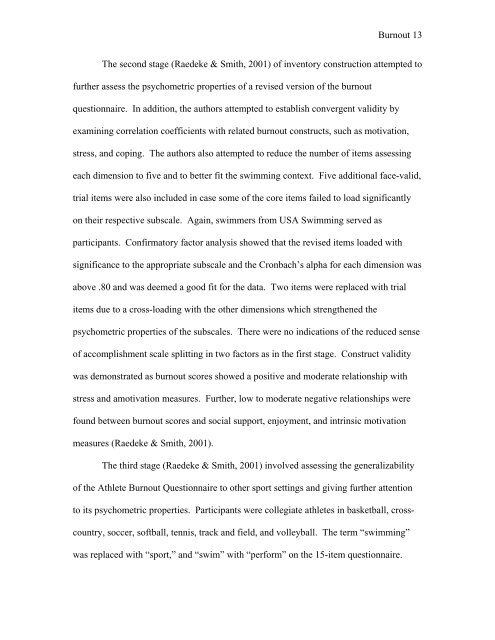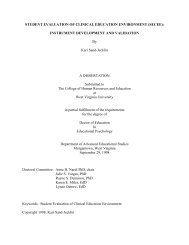Coach and Athlete Burnout - West Virginia University
Coach and Athlete Burnout - West Virginia University
Coach and Athlete Burnout - West Virginia University
You also want an ePaper? Increase the reach of your titles
YUMPU automatically turns print PDFs into web optimized ePapers that Google loves.
<strong>Burnout</strong> 13<br />
The second stage (Raedeke & Smith, 2001) of inventory construction attempted to<br />
further assess the psychometric properties of a revised version of the burnout<br />
questionnaire. In addition, the authors attempted to establish convergent validity by<br />
examining correlation coefficients with related burnout constructs, such as motivation,<br />
stress, <strong>and</strong> coping. The authors also attempted to reduce the number of items assessing<br />
each dimension to five <strong>and</strong> to better fit the swimming context. Five additional face-valid,<br />
trial items were also included in case some of the core items failed to load significantly<br />
on their respective subscale. Again, swimmers from USA Swimming served as<br />
participants. Confirmatory factor analysis showed that the revised items loaded with<br />
significance to the appropriate subscale <strong>and</strong> the Cronbach’s alpha for each dimension was<br />
above .80 <strong>and</strong> was deemed a good fit for the data. Two items were replaced with trial<br />
items due to a cross-loading with the other dimensions which strengthened the<br />
psychometric properties of the subscales. There were no indications of the reduced sense<br />
of accomplishment scale splitting in two factors as in the first stage. Construct validity<br />
was demonstrated as burnout scores showed a positive <strong>and</strong> moderate relationship with<br />
stress <strong>and</strong> amotivation measures. Further, low to moderate negative relationships were<br />
found between burnout scores <strong>and</strong> social support, enjoyment, <strong>and</strong> intrinsic motivation<br />
measures (Raedeke & Smith, 2001).<br />
The third stage (Raedeke & Smith, 2001) involved assessing the generalizability<br />
of the <strong>Athlete</strong> <strong>Burnout</strong> Questionnaire to other sport settings <strong>and</strong> giving further attention<br />
to its psychometric properties. Participants were collegiate athletes in basketball, cross-<br />
country, soccer, softball, tennis, track <strong>and</strong> field, <strong>and</strong> volleyball. The term “swimming”<br />
was replaced with “sport,” <strong>and</strong> “swim” with “perform” on the 15-item questionnaire.












